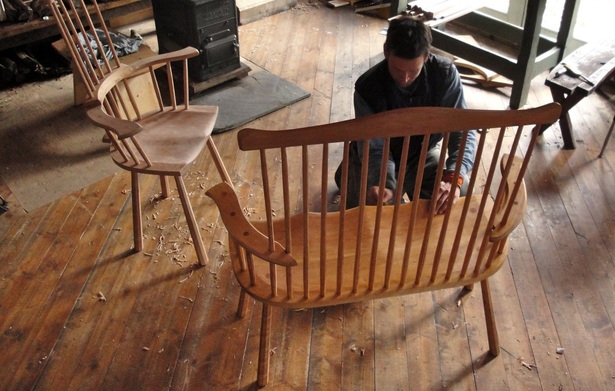
I just finished a commission for two Windsors, a settee and chair, for a company in Atlanta.
The design and construction methods for these chairs was infomed by my apprenticeship with the late Welsch chair maker, John Brown.
In keeping with all that I learned from him, I used only hand tools for the shaping and fitting of all the cherry parts.
These particular Windsors are unusual because I didn't use a lathe to turn the spindles or legs.
Instead I used a spoke shave, block plane and jack plane to square and then octagonal-ize them.
The shaping of the seat is done with an adze, followed by an in-shave, travisher and curved cabinet scraper.
The boring of the legs and spindles is done by eye and with a bit and brace (a hand-powered drill).
It took me about 75 hours to make these two chairs using only hand powered tools.
It might have gone faster with jigs, a lathe and/or power shapers, but the results would have been very different. Because I build by eye and hand, each one of my chairs is unique.
One thing John Brown taught me was "woodworking is art, not engineering."
My woodworking and teaching of working with wood are very influenced by this view.
The design and construction methods for these chairs was infomed by my apprenticeship with the late Welsch chair maker, John Brown.
In keeping with all that I learned from him, I used only hand tools for the shaping and fitting of all the cherry parts.
These particular Windsors are unusual because I didn't use a lathe to turn the spindles or legs.
Instead I used a spoke shave, block plane and jack plane to square and then octagonal-ize them.
The shaping of the seat is done with an adze, followed by an in-shave, travisher and curved cabinet scraper.
The boring of the legs and spindles is done by eye and with a bit and brace (a hand-powered drill).
It took me about 75 hours to make these two chairs using only hand powered tools.
It might have gone faster with jigs, a lathe and/or power shapers, but the results would have been very different. Because I build by eye and hand, each one of my chairs is unique.
One thing John Brown taught me was "woodworking is art, not engineering."
My woodworking and teaching of working with wood are very influenced by this view.
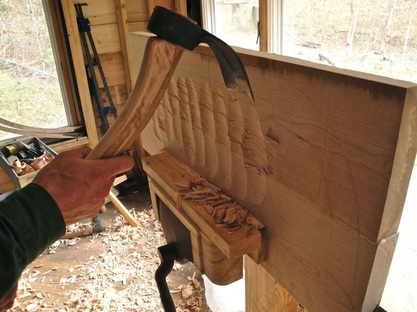
Beginning the roughing-out of the seat with an adze.
Traditionally, the Windsor seat is roughed out with the adze while the seat is attached to the floor (using a kind of vise made with blocks of wood and screws).
The chair maker swings the adze between their feet. John Brown taught me to do this in the vise upright, I believe because of his training as a boat builder before he became a chair maker.
An adze is often used upright in this way to fair in planking or a large keel rabbet.
Traditionally, the Windsor seat is roughed out with the adze while the seat is attached to the floor (using a kind of vise made with blocks of wood and screws).
The chair maker swings the adze between their feet. John Brown taught me to do this in the vise upright, I believe because of his training as a boat builder before he became a chair maker.
An adze is often used upright in this way to fair in planking or a large keel rabbet.
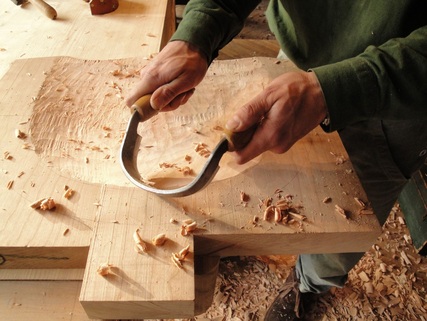
After the adze comes the smoothing out with an in-shave. This is a lot like a curved draw knife.
If it is held slightly skewed, one can get lovely shavings, even in hard cherry.
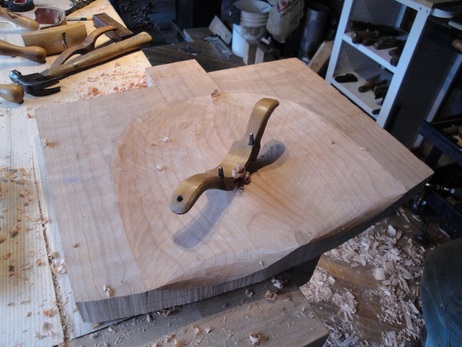
Next comes the travisher, a curved, low angle spoke shave.
The travisher you see here is one I made while I was an intern at Country Workshops in North Carolina in 1995.
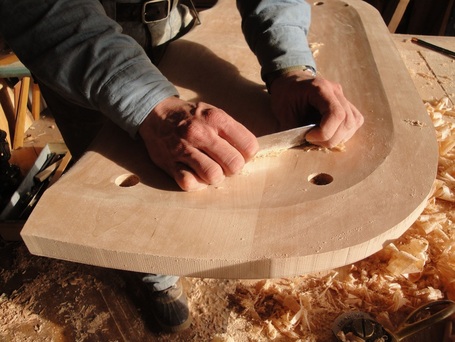
The final step in forming the seat: using a curved cabinet scraper to fair out any bits that are not yet smoothed.
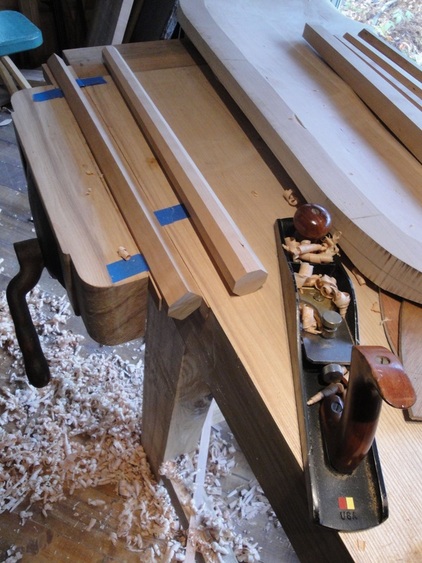
I shape the legs and spindles by eye with a jack plane, instead of turning them on a lathe.
The first step is to make them square, then they are octagonal-ized by taking down each corner in turn.
The squared leg in the vise has two of the four arrises taken down. With these tapered legs, I use wedges to fill the gap and keep the vise jaws from racking out of parallel.
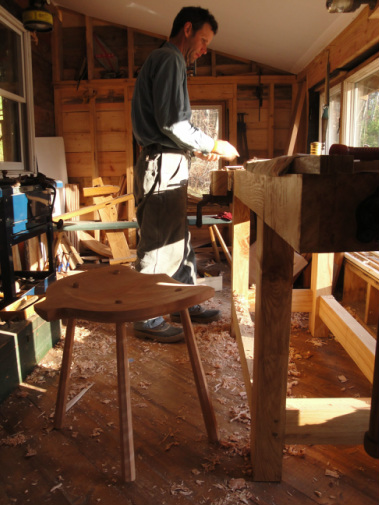
This is a view of the Windsor seat without the upper back attached.
By definition, a Windsor has a solid wooden seat with arms and legs mortised into it.
On this chair I added a bit at the back for looks only.
Occasionally on Bow Back or Sack Back Windsor chairs this bit would be used to support the arm.
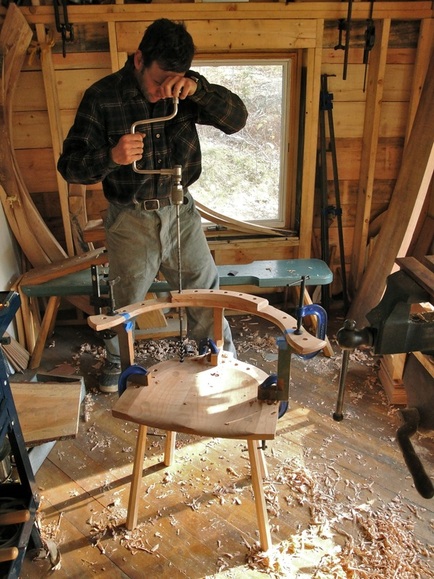
The boring is done by eye with a bit and brace.
I try and keep a strong, stable stance and the top of the brace against my head for stability and more consistent boring angles.
Boring by hand allows for the hole to be drilled more slowly and more accurately.
With the chair arm held in place by the jig (I had drilled the holes in the arm before this photo was taken), I drill down into the seat mortises below.
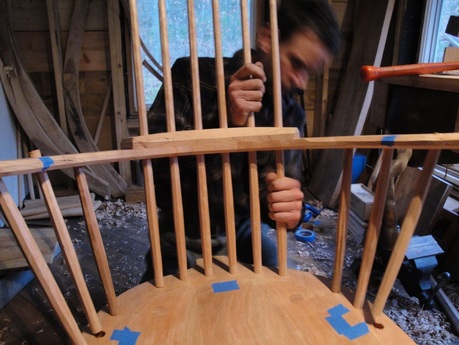
With glue setting up, the fitting of the arm and back spindles into their mortises is often a tense series of moments.
It's always exciting to see how well (or if) the boring angles and tenon to mortise jointery are harmonized.
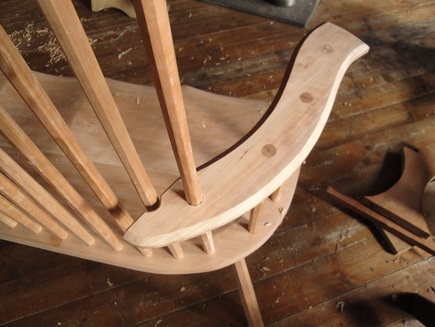
A view of the settee's arm.
Too much short grain in the arm on the back side of the spindle would have increased the chance for easy breakage.
So I extended the arm a bit longer in the back and notched it around the second spindle. Thus the wood grain runs the length of the arm and adds more strength.
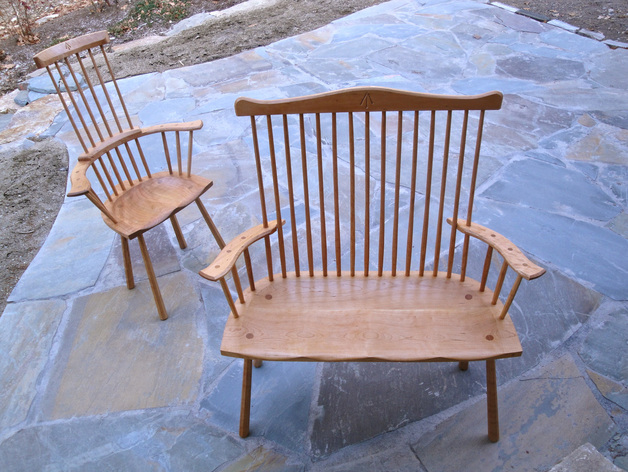

 RSS Feed
RSS Feed
